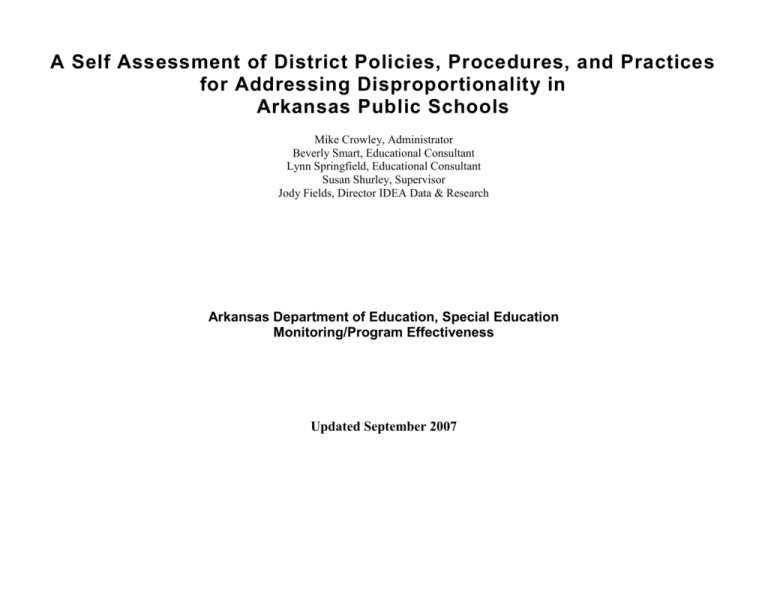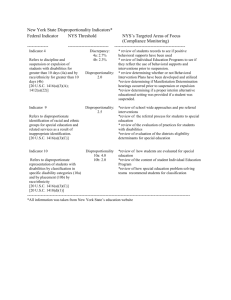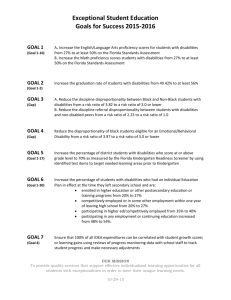Identifying and Analyzing District Data on
advertisement

A Self Assessment of District Policies, Procedures, and Practices for Addressing Disproportionality in Arkansas Public Schools Mike Crowley, Administrator Beverly Smart, Educational Consultant Lynn Springfield, Educational Consultant Susan Shurley, Supervisor Jody Fields, Director IDEA Data & Research Arkansas Department of Education, Special Education Monitoring/Program Effectiveness Updated September 2007 Table of Contents Introduction ................................................................................................................................................................................................. 3 Process for Determining That a School District is Triggered in the Area of Disproportionality ............................................................... 4 Identifying and Analyzing District Data on Disproportionality ................................................................................................................. 5 Check list for Five Procedureal Areas: ....................................................................................................................................................... 7 Intervention ........................................................................................................................................................................................................ 7 Referral .............................................................................................................................................................................................................. 8 Evaluation .......................................................................................................................................................................................................... 8 Placement ......................................................................................................................................................................................................... 10 Procedural Safeguards...................................................................................................................................................................................... 10 Review of Policies, Procedures and Practices Effecting Disproportionality ............................................................................................ 12 Attach Evidence to Support Affirmative Responses 2 Addressing the Challenge of Disproportionality in Arkansas Public Schools Introduction The major issue surrounding the concept of disproportionality in special education is the probability of discriminating against students based on race, ethnicity, and special education category. The Arkansas Department of Special Education has long been concerned about the excessive numbers of students placed in special education programs. More recently there is a growing concern for the under identification of students based on race, ethnicity, and special education category. In addition to the overall number of children receiving special education services, the number of culturally and linguistically diverse students placed in special education has been and continues to be of concern. The Individuals with Disabilities Education Act and the No Child Left Behind Act require a state agency to collect program information on disproportionality in the state’s special education programs, specifically, Section 618 of the IDEA program information. (C) Disproportionality requires the following: (1) In general, each state that receives assistance under this part … shall provide for the collection and examination of data to determine if significant disproportionality based on race is occurring in the State with respect to --(A) the identification of children as children with disabilities, including the identification of children as children with disabilities in accordance with a particular impairment…; and (B) the placement in particular educational settings of such children. An understanding of the distinction between the percent of the program by group and the percent of group in the programs are crucial to understanding disproportionate representation of culturally and linguistically diverse students in special education. Some have misunderstood the “disproportionate representation” phenomenon to mean that large percentages of a culturally and linguistically diverse group, for example, African American, are placed in a special education program, while in fact, the term means that the percentage of culturally and linguistically diverse students in the program is larger than the percentage of that group in the educational system as a whole. When a school district is cited for disproportionality of culturally and linguistically diverse students receiving special education services, being placed in special education categories of mental retardation or emotionally disturbed and/or being served in pullout educational programs, the process of self-evaluation should indicate to the district areas in which improvement can occur, as well as, areas in which the district excels. The process of examining the district’s identification, evaluation, and placement procedures and practices will enable the district to plan and implement effective interventions to remediate the situation. The underlying assumptions of discrimination are associated with the normalization construct and the causation of poor performance being inherently within the child. If children’s educational experiences are going to be affected by how they perform on norm-based assessment instruments, it is important that these assessments be valid with regard to race and ethnicity. This suggests that culturally and linguistically diverse student performance should be included in the normative sample of tests being used to determine student eligibility for special education services. Likewise, before academic performances of students can be judged to be the result of student factors alone, it is important to assess the total learning environment, which includes curriculum content, instructional materials, quality of instruction, and psychosocial climate of the classroom. It is 3 important to be aware that placing undo importance on norm-reference assessment and child centered constructs will tend to increase the probability that students will be placed in district special education programs. The purpose of this self assessment is to assist school districts in determining if identified disproportionality in the district is the result of inappropriate policies, procedures, and practices. The inappropriate policies, procedures, and practices may cause over or under identification of culturally and linguistically diverse students (a) being referred for special education services, (b) receiving special education, (c) being placed in specific disability categories, and/or (d) receiving these services out of general education settings more than eighty percent of the school day. Process for Determining That a School District is “Triggered” in the Area of Disproportionality In order to demonstrate educational equity relative to opportunity, services, and decision making, the percentage of any ethnic/racial group of students receiving special education services in a school district should be proportionally similar to the percentage of ethnic/racial group of students’ district wide. Thus, it is important to ensure that such students in a school district are not disproportionately represented in special education in contrast with such students in the district. The benchmark for disproportionality over-representation is the difference between district and special education percent by race/ethnicity. This calculation is based on those districts with less than 95% and greater than 5% in any such group. For example, the three-year average percent African American in the district for this subset of districts was 41.09% for the 2005 school year. The difference between district and special education percent African American was 4.541%, with a standard deviation of 8.611%. These averages and standard deviations may change from year to year because they are based on the three most recent years of district data. The trigger for this indicator is 1 standard deviation beyond the difference for the state, or the mean difference (4.541%) plus 1 standard deviation (8.611%) or 13.152%. Thus, for 2007, any district that had more than 13.152% of the African American ethnic/racial group of students in special education than in general education triggered in the area of disproportionality. Formula Example: Percent African American in special education – Percent African American in the district = Difference between special education and district. In 2007 if this value was greater than 13.152 for African American, then your district triggered on this indicator. If this value was negative, you were within the acceptable range (see table below). Focused Monitoring Disproportionality Over-Representation Trigger Calculation: Baseline Fiscal Years: 2002, 2003, and 2004 4 Benchmark Standard Deviation Trigger Value American Indian/ Alaskan Native Asian/Pacific Islander African American Hispanic Caucasian 0.040% -0.065% 4.541% -1.512% -3.004% 0.451% 0.554% 8.611% 3.875% 9.972% 0.491% 0.489% 13.152% 2.364% 6.968% The benchmark for disproportionality under-representation is similar to the over-representation calculations. Under-representation is the negative value of the benchmark plus two-standard deviations (-(4.541% + 8.611% + 8.611%) = -21.763%). The reason for using two-standard deviations for under representation lie with the implementation of early intervening services which is resulting in fewer referrals to special education and in turn fewer placements. Formula Example: Percent African American in special education – Percent African American in the district = Difference between special education and district. In 2007 if this value was less than -21.763 for African American, then your district would be identified as under-identifying African American students for special education services. Identifying and Analyzing District Data on Disproportionality In order for interventions to be effective, it is necessary to know why problems are occurring. To discover why problems are occurring, districts must look at data with regard to school policies, practices, and procedures currently in place in the district. Relevant data to examine may include (1) district October 1, 2006 enrollment by race, (2) special education December 1, 2006 child count by race, (3) special education December 1, 2006 child count by disability and race, (4) the 2006/07 referrals and placements by race, (5) special education December 1, 2006 child count by educational placement and race, (6) Focused Monitoring Profile, and (7) other data deemed necessary by the district. The District’s October 1, 2006 (and previous years) enrollment by race can be downloaded from ADE Data Administration website at http://adedata.k12.ar.us. The special education data, as a series of reports, will be sent to districts required to submit a self assessment. After an analysis of district data related to problem areas and possible causes have been completed, effective interventions to meet district needs can be selected. If this analysis is not done, interventions may not be effective. The questions/probes on the following pages are designed to help a district “drill down” on issues related to disproportionality. “Drilling down” on available information and data may reveal trends or patterns the district had not been aware of previously, or it may simply confirm what was already suspected. These questions/probes are not meant to be an exhaustive list, and the district may want to examine other factors. Another source of information to consider is the district’s “Special Education School Self-Assessment” (SESSA) data completed during the 2003/2004 school year. Remember, the 5 purpose of examining all this information is to help districts discover why problems are occurring in order to provide direction in selecting effective interventions. Disproportionate representation is a problem when students receive low-quality instruction. This problem may arise in the regular classroom, where opportunities for academic success may be restricted, or in the special education classroom, where a student’s educational progress may falter due to lowered or inappropriate expectations and goals. At a minimum, a self-evaluation of disproportionate representation should include a review of the district’s policies and procedures in five specific areas. These include general education intervention, referral, evaluation, placement, and procedural safeguards. 6 Checklist for Review of Five Procedural Areas: Intervention, Referral, Evaluation, Placement, and Procedural Safeguards Intervention If no - provide possible If yes – provide recommendations evidence and solutions Indicators Does the district use a specific general education intervention program for students experiencing difficulty in the regular education classroom? (e.g. peer tutoring, after-school remediation program, etc.) If yes, identify where teachers and others interested in the process can find a written description of the program Does the district (and each building within the district) have a collaborative team structure in place to engage in problem solving and data-based decision making for both behavior and academics? Does the district provide assistance to regular classroom teachers in the development of specific inschool regular education program accommodations and interventions? If yes, describe the activities/professional development conducted to accomplish this undertaking. Is the effectiveness of the accommodations and interventions reviewed regularly? If yes, describe when and how this is accomplished. What does the district use to progress monitor the effectiveness of academic and behavioral interventions? Have educational intervention programs been implemented in all district schools? A building-bybuilding review of data may reveal that some school’s programs are not as effective as others as noted by the disproportionate numbers of culturally and linguistically diverse students enrolled in its special education program. If yes, how is the effectiveness of those building interventions reviewed? 7 Personnel Involved Referral Referrals are greatly improved when districts can answer “yes” to each of the following questions. Indicators If no - provide possible If yes – provide evidence recommendations and solutions Personnel Involved Does the district ensure consistent application of the referral criteria? If yes, describe how referrals are monitored. Does the district randomly review referrals to detect any pattern that might indicate a problem with disproportionately large numbers of children of one race referred by a teacher of another race? If yes, describe how this is accomplished. Is the effectiveness of the referral policy reviewed? If yes, describe how that effectiveness is monitored. Evaluation This review is intended to provide a greater understanding of the evaluation process and assist district personnel as they monitor their special education culturally and linguistically diverse enrollments. Indicators Identify all tests and other educational materials currently used in the evaluation process. Has each been validated for the specific purpose for which it is used? Are tests and other evaluation materials administered by trained personnel in conformance with the instructions provided by their producer? Are all tests utilized by the district tailored to assess specific areas of educational need and not merely designed to provide a single, general intelligence quotient? 8 If no - provide possible If yes – provide evidence recommendations and solutions Personnel Involved Evaluation This review is intended to provide a greater understanding of the evaluation process and assist district personnel as they monitor their special education culturally and linguistically diverse enrollments. Indicators Does the district have well written criteria for the identification of special education students in its policy/procedure manual? Have tests been selected to ensure an accurate reflection of the student’s aptitude or achievement, or whatever factor the test purports to measure? In making placement decisions, does the district use a variety of informational sources including: aptitude tests, achievement tests, social or cultural background, adaptive behavior, teacher recommendations, past educational history, physical conditions Are all the district personnel who participate in placement decisions knowledgeable about: the student, the meaning of the evaluations, placement options, family perspectives Is all information, regardless of its source, carefully considered and documented? Identify all tests and other educational materials currently used in the evaluation process. Indicate if each been validated for the specific purpose for which it is used? Are those conducting the evaluations sensitive to cultural differences between groups? 9 If no - provide possible If yes – provide evidence recommendations and solutions Personnel Involved Placement The decision to place students in special education carries with it lifetime implications that are not easily overcome. Questions to address in this area include: Indicators If no - provide possible If yes – provide evidence recommendations and solutions Personnel Involved What steps does the district take to regularly review the ethnic composition of its special education programs? When racially disproportionate special education programs are identified, how does the district determine that students are being provided appropriate programs and services that meet their unique educational needs? When disproportionate representation exists among categories in special education, how does the district examine its placement decisions to detect any possible differences by ethnicity/race and placement? When racially disproportionate special education programs are identified, what type of timely action is taken to review the appropriateness of the program for those enrolled? Procedural Safeguards Procedural safeguards provide protection for students, parents, and educators alike. Indicators Are all records relevant to the identification, evaluation, or educational placement of a disabled student made available to the student’s parents? Are district parents, staff and the community provided demographic information about the ethnic/racial make-up of the special education programs in the district? 10 If no - provide possible If yes – provide evidence recommendations and solutions Personnel Involved Procedural Safeguards Procedural safeguards provide protection for students, parents, and educators alike. Indicators What steps are taken to ensure that parents of culturally and linguistically diverse children understand the special education process and potential benefits of participation in special education services? Are all evaluations conducted in a timely manner in accordance with the state’s “Special Education Eligibility Criteria and Program Guidelines for Children With Disabilities Ages 3-21? In initiating the Procedural Safeguards required by the IDEA from referral through developing and implementing IEPs, does the district ensure that all timelines are strictly adhered to in accordance with the state’s “Special Education and Related Services: Procedural Requirements and Program Standards?” 11 If no - provide possible If yes – provide evidence recommendations and solutions Personnel Involved Review of Policies, Procedures, and Practices Effecting Disproportionality Review of Policies, Procedures and Practices Effecting Disproportionality If no - provide possible If yes – provide evidence recommendations and solutions Personnel Involved Indicators The district provides peer tutoring, learning strategies, or other similar programs. 1. Of the above programs, which programs are available for grades K-12? 2. Are the above programs available in all schools within the district? If no, in which schools are they provided? Regular classroom teachers and administrators are trained in how to make adaptations and accommodations within the regular classroom to assist students who are experiencing problems. Regular classroom teachers engage in consistent progress monitoring and documenting the educational interventions and the effects of such intervention(s) on a child experiencing academic problems before referring the child for special education. The school district offers alternative compensatory programs available to all students throughout the district, grades K-12. The district has a systematic program to assist teachers in the development of intervention strategies for students who are experiencing problems. Administrative personnel are involved with the multidisciplinary team process. The district reviews achievement scores of all students; scores are reviewed in conjunction with (a) Identification of teachers with high referral rates – for all ethnicities and gender; (b) Population of individual classes by ethnicity; (c) and staffing ratios. The district provides internal monitoring for its special education 12 Review of Policies, Procedures and Practices Effecting Disproportionality If no - provide possible If yes – provide evidence recommendations and solutions Personnel Involved Indicators programs. The district provides professional development and training for changes in instructional techniques that match students’ learning styles. The schools evaluate how materials/instructions are presented to students. Schools check for mismatches of student skills/deficits to teaching approaches. The district keeps data on the amount of progress by students in special education programs, i.e. pre and post evaluation using criterion referenced instruments. Data on student achievement in special education programs are being kept according to student ethnicity/race, gender, grade, school, class, and type of placement. The district uses special education achievement data to identify problem areas with the learning process. The district has considered a variety of factors which may be adversely impacting student learning, such as: (a) lack of instruction and (b) lack of prerequisites for acquisition of new skills or social factors such as: (a) the number of schools attended (i.e. mobility) and (b) the support system The district provides inservice to: review literature and research regarding teacher expectations for all ethnic/cultural differences especially black males; observe/provide feedback to teacher; and monitor teacher behavior on an ongoing basis. 13 Review of Policies, Procedures and Practices Effecting Disproportionality If no - provide possible If yes – provide evidence recommendations and solutions Personnel Involved Indicators Regular classroom teachers and administrators are trained in the characteristics of various disabling conditions. Regular classroom teachers and administrators are trained in what their responsibilities are prior to referral being made and after a referral has been made. The district keeps data that furnishes the following information related to referrals: Number of referrals made by school and individual teacher; Number of referrals made according to student age, grade, gender and ethnicity/race; Number of referrals made versus number of placements made; Number of students transferring into the district that are receiving special education services. Psychological, Educational Examiners, and Speech/Language Pathologists employed by or contracted with the district receive inservice training concerning current best practices in evaluation procedures. A multidisciplinary team of professionals with knowledge in the area of suspected disabilities conducts the evaluation. Multidisciplinary team members have received training that delineates for them each person’s specific areas of responsibility. The district has effective procedures in place for acquiring and disseminating to teachers and administrators significant information concerning promising educational practices for disabled students. This may include such areas as: Identifying and evaluating new assessment instruments and techniques; 14 Review of Policies, Procedures and Practices Effecting Disproportionality If no - provide possible If yes – provide evidence recommendations and solutions Personnel Involved Indicators Promising educational practices derived from educational research; Providing opportunity to attend outside district inservices, workshops and conventions; Professional literature accessible to teachers at a central location. Multidisciplinary team members are knowledgeable about the meaning of evaluation data. The person(s) responsible for interpreting assessment data has received training concerning the interpretation and use of assessment results Assessment results are reported in standard scores for appropriate comparison. The multidisciplinary team has considered closely the results of instruments that measure adaptive behavior when assessing all students. The adaptive behavior instruments are normed for the population for which they are being used. Adaptive behavior instruments in use provide for measuring adaptive behavior in the following areas: School; Home; and Community Assessment instruments that evaluate speech/language are normed for the population for which they are being used. The comprehensive evaluation involves information from an assortment of sources (classroom teachers, parents, counselors, others) and utilizes a variety of evaluation techniques (observation, interviews, informal and formal testing, etc.) The multidisciplinary team addresses the areas of exclusion 15 Review of Policies, Procedures and Practices Effecting Disproportionality If no - provide possible If yes – provide evidence recommendations and solutions Personnel Involved Indicators under 34 CFR 300.309 in the criteria for determining the existence of a specific learning disability, paying particular attention to 34 CFR 300.311(a)(6) which addresses environmental, cultural or economic disadvantages. The school follows requirements for multidisciplinary team members for students suspected of having a learning disability as outlined under 34 CFR 300.308. The multidisciplinary team considers cultural/ethnic, as well as dialectal variations in selecting assessment procedures and analyzing evaluation data, especially for culturally and linguistically diverse students suspected of being speech/language impaired. The multidisciplinary team reviews/considers all school records. The evaluation report describes the reason for referral. The evaluation report lists the purpose of assessment and the full names of all procedures used and who administered each test. The evaluation report contains the student’s developmental history. The evaluation report contains the student’s educational history. The evaluation report provides relevant and current information about the student’s family/home environment and functioning within that environment. The evaluation report provides a statement of the student’s current level of educational functioning. Assessment results are reported as estimates showing standard error of measurement, rather than exact indicators of skill or 16 Review of Policies, Procedures and Practices Effecting Disproportionality If no - provide possible If yes – provide evidence recommendations and solutions Personnel Involved Indicators ability. Assessment results of standardized tests are reported in terms of standard scores for appropriate norm groups. Evaluation reports provide appropriate alternative explanations of performance. Evaluation reports indicate the presence of a specific disability(s) and the basis for that determination. Specific recommendations for instructional and/or behavioral interventions are offered. Persons who conduct evaluations participate in the decisionmaking process. The district has procedures for exploring adjustments in the regular education program to meet the student’s needs prior to referral for special education. The district provides for the student if he/she is not found eligible for special education services. Placement decisions are determined by each child’s individual needs being met in the least restrictive environment rather than by the disability. The district routinely evaluates the effectiveness of special education programs in relation to other alternatives. Teachers are using a variety of alternative instructional approaches appropriate to the varied developmental levels, learning styles, and current levels of performance of students. All special education students are accomplishing goals and 17 Review of Policies, Procedures and Practices Effecting Disproportionality If no - provide possible If yes – provide evidence recommendations and solutions Personnel Involved Indicators objectives on the IEP. The district has a systematic method for evaluating program effectiveness, staff behaviors and attitudes, program impact, and student progress. IEP goals and objectives are developed which address deficit skills in the areas of adaptive behavior for children identified as mentally retarded. The district has systematic methods for monitoring the reintegration of special education students into regular education which insures that: Methods are reviewed annually Students are considered for lesser restrictive environments at least annually (i.e. at annual review) IEPs of secondary students reflect vocational or transition needs. The district keeps data that reflects the movement of special education students both to a more restrictive environment and to a lesser restrictive environment according to age, gender, grade, race, and individual school. 18







